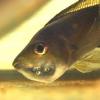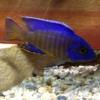I have a breeding group of fuelleborni which I’ve enjoyed for several years. Over those years I’ve raised a fair few fry from them. On a couple of occasions I’ve notice a single fry far paler than its siblings, and apparently having pink eyes – an albino. On both occasions I watched with interest, but the fish didn’t grow at the same rate as the other fry, and perished within a few weeks.
A couple of weeks back I got a call from a shop I’d sold some fuelleborni to. One of their customers had bought my fish and bred from them. A single albino had been produced, and survived. Now around 5cm, would I like it? Although I’m not exactly a fan of albinos myself, I thought this might be an interesting little project. The little guy arrived here last week.
A couple of days ago I collected fry from three of my Melanochromis kaskazini girls. One brood didn’t look too crash hot – apparently three crook or dead ones amongst the 12 fry. I didn’t think too much about it until I took a close look at the fry today. Those three fish weren’t dead. They are very much alive – they just don’t have the colour of the others!!!!
I’ve been doing a little reading on the subject of albinos. Apparently, while albinos in fish fry aren’t that uncommon, research tends to indicate that the albinism gene is generally semi-fatal, with only a small percentage of albino fry surviving. This corresponds with my experience in the past with the albino fuelleborni fry I've seen in my broods, and friends with bristlenose catfish tell of similar experiences. One research paper cites only 29 fish reaching maturity from 800 albino medaka embyos.
Well, it’s further piqued my interest. I’d love to hear of other people's experiences with finding odd albinos in the broods of normal coloured cichlids. How did they fare?
Also, if you keep one of the albino strains of cichlids, do you find them less hardy than their normally coloured brethren? Is the survival rate of their fry on par with the normal coloured equivalent?
Edited by humbug, 17 May 2016 - 01:51 PM.















